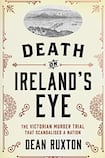
On a fine September morning in 1852, a stylish couple took a boat from Howth harbour for a day trip to the nearby small, uninhabited island of Ireland’s Eye. William Kirwan, a successful artist, worked mainly for Dublin hospitals, drawing patients’ diseases and injuries; his wife, Maria (née Crowe), enjoyed nature walks and was a strong swimmer.
When boatmen returned to fetch the couple that evening, Maria’s dead body was found on a rock. Although witnesses testified to hearing screams from the island, the coroner concluded she’d drowned. But the local police sergeant was suspicious, and when it emerged that Kirwan had been living with another woman with whom he had several children, Maria’s body was exhumed and he was arrested for murder.
His trial was “an undoubted sensation in the capital, the country and abroad”, and the section in Dean Ruxton’s book on it is particularly well presented, with examination and cross-examination of witnesses given in intriguing and dramatic detail.
An interesting aspect of the aftermath of the trial (Kirwan was found guilty) was “the war between the Irish press and certain sections of the English press”. The latter curiously portrayed the heinousness of the crime as somehow typically Irish but, even more curiously, considered the guilty verdict absurd and lambasted the functioning of the justice system in Ireland.
Kirwan’s sentence was commuted to deportation and life in prison, which caused public bewilderment. Such was the media furore over the verdict and subsequent commutation that the jury felt compelled to take the perhaps unprecedented step of writing a letter justifying exactly why they came to their verdict. Ruxton meticulously and forensically examines the evidence, with some help from modern experts in various relevant fields, to reach his own conclusion about Kirwan’s guilt or innocence.
The author relies on a wide range of documents, including pamphlets, court reports, the prosecution brief and dozens of Irish and UK newspapers, in what he says is “intended to be a detailed retelling of a truly tragic story and an attempt to honestly examine an extraordinary chapter in Ireland’s criminal history”. He succeeds admirably in both endeavours, while honestly acknowledging that “a key to unlock a more complete truth about what happened” died in obscurity with William Kirwan.












